ST PETER'S QUARTER TRAIL - BABINGTON LANE
ST PETER’S QUARTER – 2 BABINGTON LANE
Stylish and absorbing St Peter’s Quarter is a sure-fire winner.
Looking down Babington Lane
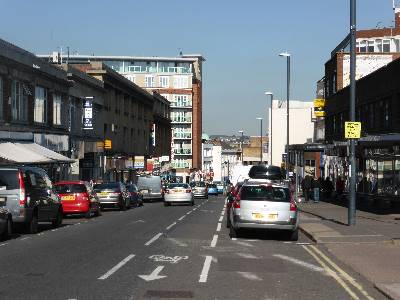
Like Green Lane, Babington Lane provides an important entry point into the centre of Derby from Normanton and the south. But not for unauthorised vehicles, which are directed across Gower Street or Sitwell Street. Many of the buildings in the street are 20th century and home to long-established businesses.
Before the forming of Babington Lane, two large houses and their gardens occupied the area. Namely Babington House and Abbot’s Hill House.
At the northern end of Babington Lane are Babington Buildings. They were designed by Methodist chapel architect John Wills for Hull-born entrepreneur Councillor G E Franklin. The lower end of Babington Lane was where people once went to be entertained. Because as well as the former Grand Theatre, halfway between St Peter’s and Gower Street was the Midland Electric Theatre/Picture House. It opened on 27 July 1910 and closed on 27 August 1960.
Gower Street
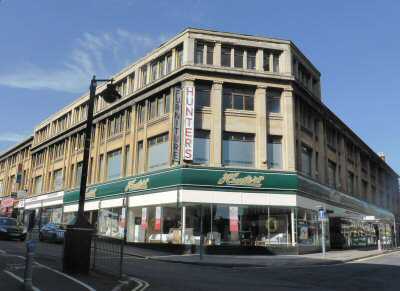
Green Lane and Babington Lane are linked by Gower Street. It was formerly known as Blood Alley. The street has been in existence as a thoroughfare since at least 1610. It was widened and later renamed after William Leeson Gower, a local MP from 1847-52. The former Presbyterian Chapel is at the western end of the street and Hunter’s departmental store is at the other. The street contains an assorted mix of residential, public and commercial buildings, with considerable differences in style and scale.
Hunter’s Furnishing Store is on the corner where the high garden wall of Abbott’s Hill House used to run. The store was built in the late 1920s after the demolition of Abbott’s Hill House. It is Derby’s longest-established furniture store. Abbott’s Hill House and Gardens were built in 1715, by Simon Degge FRS, and occupied the site of a much earlier house.
Babington Arms
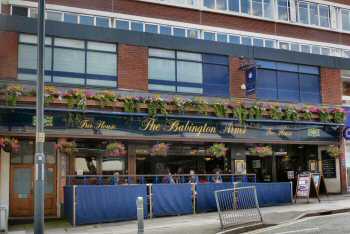
Situated a quarter of the way up Babington Lane, facing towards Gower Street is Babington Arms. The site on which it stands was redeveloped in the early 1960s. The pub was opened in 1997 and is part of the J D Wetherspoon pub chain. It revives memories of a previously well-known pub of the same name that closed in the mid-1920s.
During the summer and at other times of the year when the weather is suitable. The frontage of the pub is opened up to provide an unusual platform seating area. This enables customers to enjoy their refreshments in a slightly elevated position above street level.
Grand Theatre

The former Grand Theatre is now a restaurant. However, you can still see the old name clearly above the entrance. It was built on land formerly occupied by the gardens of Babington House.
It was Birmingham theatre manager, impresario and actor Andrew Melville who got the ball rolling to open a theatre. When he visited the town on October 9th 1885. He bought a site on Babington Lane. Contracted an architect and builders and, in a matter of 4 months, the Grand Theatre was ready to open. Six weeks later, 40 minutes before the evening performance was due. A fringe overhanging a wooden scene caught fire. The staff tried to put it out, but to no avail and two men perished in the ensuing blaze.
In a matter of only a few months, the theatre was rebuilt bigger and better than before.
Over the next 64 years, it staged a wide variety of entertainment, including playing host to some of the biggest names in British entertainment. In 1901, the famous actress, renowned beauty and mistress of the Prince of Wales, Lillie Langtry, performed there. She was a few years past her heyday and had long been replaced in the affections of the new King Edward VIII. But she was still a famous name and the audience loved her. Sir Henry Irving visited in 1904 and Gracie Fields brought the town to a standstill. When she did a charity concert there in 1938.
Count Dracula
It was Count Dracula who wrote The Grand into theatrical history. The first performance of the first stage adaptation of Bram Stoker’s famous vampire novel, Count Dracula, was played at The Grand on Thursday, 15th May 1924. The play went on to be a London hit and Count Dracula became a household name. In 1922, Ivor Novello, by then an established film star, appeared in ‘The Rat’. During the Second World war many stars, like John Gielgud and Peggy Ashcroft, Anna Neagle and Vivian Leigh, performed in plays that were about to be debuted in London’s West End.
As well as dramas comedies and musicals, variety shows and reviews were also staged at the theatre. Arthur Askey and Vera Lynn were among the stars featured. Max Bygraves made his review debut at The Grand. Frankie Howerd appeared well down the bill, returning at a later date as the star of the show. Ice shows, water shows and circuses have also been held there.
Unfortunately, the theatre had its limitations despite significant redecoration in 1948. It was not possible to expand the theatre’s seating capacity. Also, little could be done to improve the general facilities in what was becoming a more demanding era. This led the Grand’s proprietor, Prince Littler, to begin looking for something more suitable. He acquired the Hippodrome in Green Lane and closed the Grand on 9 December 1950. The stage equipment was transferred to the Hippodrome which opened on 23 December.
After closing the Grand remained empty for seven years. Until Mecca acquired the building and it became the Locarno Ballroom. Only the main 1886 façade survives, the remainder of the building having been completely reconstructed in 1959. Following several name changes, the building is now occupied by a restaurant.
Babington Buildings

Babington Buildings were designed by Methodist chapel architect John Wills for Hull-born entrepreneur Councillor G E Franklin. He was the proprietor of a national footwear chain called the Public Benefit Boot and Shoe Company. It had its branch on the ground floor and rented out the upper floors. The premises are now occupied by Waterstones Bookshop. High up at the front of the building are two baboons carved on either side of a barrel or tun – ‘baboon-tun’. This is interpreted as Babington.
The building is named after Babington House, which was built in 1626 for Henry Mellor, later to become Derby’s first mayor. It was an imposing mansion, situated opposite Babington Hall and, entered from the street through a four-centred ‘Tudor’ arch. This was decorated with three heraldic beasts set in the high perimeter wall. According to the hearth tax returns for 1670, it was the largest single residence in Derby. Originally known as St Peter’s House, it was set on 13 acres of parkland and flower beds. To the east, it was bordered by Osmaston Road and the gardens of the old Babington Hall.
Babington Hall plaque

A plaque on the wall of the Nat West Bank marks the site of Babington Hall. This was where Mary Queen of Scots was detained in Derby on 13 January 1585 and guarded by Sir Ralph Sadler. She stayed at a time when the hall was let to Henry Beaumont whose wife acted as her hostess. Anthony Babington had acted as a page to Mary and as a Roman Catholic supported her cause. In 1586, he was persuaded to take a leading role in a plot to assassinate Queen Elizabeth and place Mary on the throne. Babington Hall was sold to raise funds for the ultimately unsuccessful plot, which led to both his and Mary’s execution.
The Spot
The Spot is a well-known Derby landmark. From where it is possible to look down St Peter’s Street and follow the line of the ancient north-south trackway, which existed long before the town came into existence. In the 1750s, The Spot was the point from where the new London turnpike road diverged from the old route via Osmaston and Swarkestone Bridge. Exactly how it got the name is a curiosity. As no one seems to know from where it was derived, although there are several theories.

For just over 20 years the bronze statue of Queen Victoria, donated by the famous Derby Engineer, Sir Alfred Seale Haslam was located at The Spot. King Edward VII visited Derby to unveil the statue of his mother, on 28 June 1906. Queen Victoria made her only state visit to Derby in 1891. When she laid the foundation stone of the new Derbyshire Royal Infirmary, and during the course of her visit knighted the Mayor, Alderman Alfred Seale Haslam at Derby Railway Station.
In 1925, the statue was moved to the grounds of the former Derby Royal Infirmary. It was considered too heavy, to allow a planned underground toilet block to be built on the site. Also, redevelopment took place at the Spot as part of the City Council’s Derby Promenade scheme of the 1990s. As part of the redevelopment plan, a clock tower was added and the underground toilet block became even less conspicuous than it had been. The toilet block has now been removed and an open space created.
Royal Crown Derby (Outside St Peter’s Quarter)
Following the coming into existence of the Derby Poor Law Union in 1837, the Poor Law Commissioners had the first Derby Union Workhouse built on Osmaston Road. The building of a new Derby Union Workhouse on Uttoxeter Road led to the site on Osmaston Road being put up for sale in 1876. It was purchased by the Royal Crown Derby Company for the establishment of a new factory.
The story of Derby China dates back to the mid-1700s, when Andrew Planche, a Huguenot, established the first china works in a rented property in Derby. He was joined by William Duesbury a businessman and potter from Longton, Staffordshire who bought the property on Nottingham Road and became the dominant figure in the business. Duesbury took on many skilled painters and figure modellers and, in 1770; he purchased the famous Chelsea factory. The uniqueness of Derby porcelain was recognised by King George III. In 1775, he granted the factory the rare honour of being able to incorporate a crown on its ware and in its name.
After his father died in 1786, William Duesbury II set about making the Derby China Works the finest in Europe. Unfortunately, he died in 1797 at the age of 34 and the factory went into temporary decline losing many of its skilled workers. Until Robert Bloor took control of the factory in 1811 and restored its reputation.
Osmaston Road Factory
The eventual move to the new site on Osmaston Road signalled a period of further growth and diversification. In 1890, Royal acclaim followed when the company was appointed ‘Manufacturers of porcelain to Her Majesty’.
Following several changes in ownership, the business was acquired in 2013 by one of the world’s most successful ceramic brands, Steelite International. The company is committed to maintaining the same high standards as previously attained. At the same time as looking for new markets for fine bone china tableware throughout the world. An order was recently received from the Dorchester Hotel in London. In addition to several others from the high-end market. Visitors can enjoy a light meal in style, or just a cup of coffee in the spacious café. They can also enjoy a browse in the shop. Factory tours can be arranged. A visit is highly recommended.
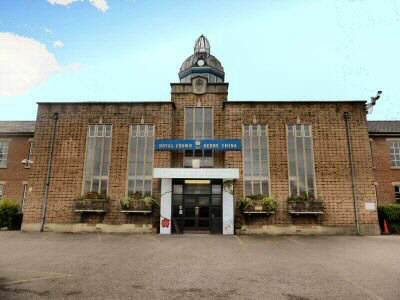
The Arboretum (Outside St Peter’s Quarter)
Joseph Strutt, the third son of the great industrialist Jedediah, donated the Arboretum to the people of Derby. He was a great social reformer and recognised the fact that the working classes, though better off than their predecessors regarding housing and working conditions, were being deprived of open space. His mission was to provide a “Pleasure Ground or Recreation Ground to offer the inhabitants of the town the opportunity of enjoying, together with their families, exercise and recreation in the fresh air, in public walks and grounds devoted to that purpose.”
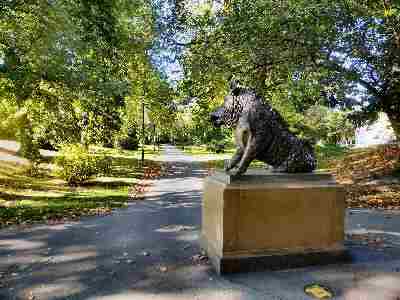
Strutt commissioned John Claudius Loudon, a renowned writer and garden designer, to draw up the plans. Loudon laid the park out with mounds planted with trees and shrubs to disguise the paths, and park boundaries to give the illusion of space. No two species of tree or shrub were the same in the 11-acre park. When the task had been completed by Loudon. Strutt named the park, ‘The Arboretum.’ It was opened on 16 September 1840 and became England’s first public park.
A popular attraction in the park was the Florentine Boar. It was a hollow earthenware copy made by William John Coffee from 19th-century drawings of an original bronze fountain. That sits on the edge of the Marketo Nuovo in Florence. Although it was refurbished in 1934, bomb damage during the Second World War caused it to be removed. Following years of decline, funding was obtained from the Heritage Lottery Fund, the Council and other sources, and the Arboretum, together with the boar, were restored to its former glory early in 2007.
